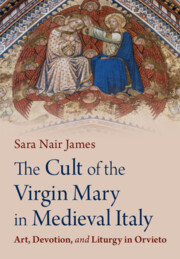Refine search
Actions for selected content:
287 results
6 - Organizing Networks to Supply Mediterranean Markets
-
-
- Book:
- Palmyra, the Mediterranean and Beyond
- Published online:
- 21 October 2025
- Print publication:
- 16 October 2025, pp 127-140
-
- Chapter
- Export citation
5 - Episodes in Rival Narratives
-
- Book:
- The Narrative Conflict of Traditions in the Late Antique World
- Published online:
- 22 September 2025
- Print publication:
- 09 October 2025, pp 158-197
-
- Chapter
- Export citation
Chapter 21 - Rome
- from France, Italy, and Iberia
-
-
- Book:
- The Cambridge Guide to Global Medieval Travel Writing
- Published online:
- 03 October 2025
- Print publication:
- 02 October 2025, pp 375-392
-
- Chapter
- Export citation

English Madrigals on the Jesuit Stage
- Musical Theatre of Martyrdom at the Venerable English College, Rome
-
- Published online:
- 30 September 2025
- Print publication:
- 30 October 2025
-
- Element
- Export citation
Wayfinding in the Roman City: A Subaltern Spatial Modality
-
- Journal:
- Antichthon , First View
- Published online by Cambridge University Press:
- 16 September 2025, pp. 1-30
-
- Article
- Export citation
4 - Potnia of the Labyrinth, Initiation of the King, and the Triple Sacrifice
-
- Book:
- Myth, Ritual, and Society in Mycenaean Anatolia
- Published online:
- 18 July 2025
- Print publication:
- 07 August 2025, pp 131-161
-
- Chapter
- Export citation
2 - Mycenaean and Vedic Sacrificial Posts
-
- Book:
- Myth, Ritual, and Society in Mycenaean Anatolia
- Published online:
- 18 July 2025
- Print publication:
- 07 August 2025, pp 47-66
-
- Chapter
- Export citation
6 - Nart Saga, Indo-Iranian Twins, and Dioscurias
-
- Book:
- Myth, Ritual, and Society in Mycenaean Anatolia
- Published online:
- 18 July 2025
- Print publication:
- 07 August 2025, pp 194-237
-
- Chapter
- Export citation
7 - Rome 1977
-
- Book:
- Dreams and Songs to Sing
- Published online:
- 07 August 2025
- Print publication:
- 07 August 2025, pp 119-141
-
- Chapter
- Export citation
3 - Mycenaean Leaders in the Context of Indo-European and Indo-Iranian Society and Ritual
-
- Book:
- Myth, Ritual, and Society in Mycenaean Anatolia
- Published online:
- 18 July 2025
- Print publication:
- 07 August 2025, pp 67-130
-
- Chapter
- Export citation

The Cult of the Virgin Mary in Medieval Italy
- Art, Devotion, and Liturgy in Orvieto
-
- Published online:
- 24 July 2025
- Print publication:
- 24 July 2025
2 - Money and Technology in Ancient Times
-
- Book:
- Money In Crisis
- Published online:
- 15 July 2025
- Print publication:
- 12 June 2025, pp 14-45
-
- Chapter
- Export citation
6 - Musical Empires
- from Part II - Aelius Aristides’ Lyric
-
- Book:
- Aelius Aristides and the Poetics of Lyric in Imperial Greek Culture
- Published online:
- 01 May 2025
- Print publication:
- 15 May 2025, pp 224-269
-
- Chapter
- Export citation
Chapter 20 - Empire
- from Part II - Intellectual, Cultural, and Political Contexts
-
-
- Book:
- Percy Shelley in Context
- Published online:
- 17 April 2025
- Print publication:
- 24 April 2025, pp 150-157
-
- Chapter
- Export citation
Alexander and the Elephants
-
- Journal:
- Comparative Studies in Society and History / Volume 67 / Issue 3 / July 2025
- Published online by Cambridge University Press:
- 10 April 2025, pp. 707-730
-
- Article
-
- You have access
- Open access
- HTML
- Export citation
6 - Gregory VII and the Reform Movement
- from Part II - Crises, Schisms, and Dissent
-
-
- Book:
- The Cambridge History of the Papacy
- Published online:
- 28 February 2025
- Print publication:
- 20 March 2025, pp 161-184
-
- Chapter
- Export citation
5 - Papal Tombs in the Middle Ages
- from Part I - Spaces, Liturgies, Travels
-
-
- Book:
- The Cambridge History of the Papacy
- Published online:
- 28 February 2025
- Print publication:
- 20 March 2025, pp 151-185
-
- Chapter
- Export citation
1 - Inventing Peter in Late Antiquity
- from Part I - Christendom and Empire
-
-
- Book:
- The Cambridge History of the Papacy
- Published online:
- 28 February 2025
- Print publication:
- 20 March 2025, pp 35-55
-
- Chapter
- Export citation
7 - The Myth of Pope Joan
- from Part II - Women, Gender, Sexuality
-
-
- Book:
- The Cambridge History of the Papacy
- Published online:
- 28 February 2025
- Print publication:
- 20 March 2025, pp 221-245
-
- Chapter
- Export citation
2 - Urbi et Orbi: The Pope, Rome, and the Modern World
- from Part I - Spaces, Liturgies, Travels
-
-
- Book:
- The Cambridge History of the Papacy
- Published online:
- 28 February 2025
- Print publication:
- 20 March 2025, pp 71-95
-
- Chapter
- Export citation
